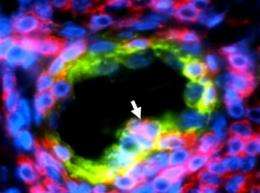Blood vessels participate in the eradication of tumors

Breast cancer: for the first time, very specific blood vessels have been discovered in tumors. These vessels facilitate the access of certain white blood cells, known as “killer lymphocytes”, into tumor tissues and thus lead to the efficient destruction of tumors. This work, led by Jean-Philippe Girard, Inserm senior researcher at the Institut de Pharmacologie et de Biologie Structurale, in collaboration with the Institut Claudius Regaud, is published in the journal Cancer Research (August 2011).
A category of white blood cells, called “killer lymphocytes”, has the function of recognizing and destroying cancerous cells in the body. However, the eradication of the disease requires the presence of a large number of killer cells in contact with the tumors. How do these lymphocytes manage to penetrate the tumors in order to destroy them? Although the mechanism has been shrouded in mystery until now, Girard's team at the Institut de Pharmacologie et de Biologie Structurale, in collaboration with researchers from the Institut Claudius Regaud, has lifted the veil on how lymphocytes infiltrate into tumors. By carrying out a study involving nearly 150 patients suffering from breast cancer, the scientists discovered the presence of a particular type of blood vessel, known as HEVs, in tumors. Normally, these HEV vessels are present in the lymph nodes where they serve as port of entry for lymphocytes from the blood. The cells lining the walls of these HEV vessels are bulging and rounded and this very characteristic morphology facilitates the passage of lymphocytes from the blood into the tissue.
The Toulouse-based team discovered that the presence of a large number of killer lymphocytes in breast tumors was linked to the presence of a large number of HEV vessels in these tumors. This suggests that, as in lymph nodes, HEVs constitute the port of entry for lymphocytes into tumors. In addition, the researchers observed that when a tumor contains many HEV vessels, the patients are more likely to recover. The presence of these HEV vessels in a tumor could thus be a favorable prognosis factor.
The next steps for the researchers will be to confirm these results on larger groups of patients and to study the influence of HEV vessels on the response to therapeutics (chemo- and radiotherapy) widely used in breast cancer treatment. Studies are also underway to examine the role of HEV vessels in melanoma and cancer of the ovaries and the colon. The longer-term objective is to increase the quantity of HEVs in tumors and/or to make them form in tumors that do not have them, so as to enable a massive recruitment of killer lymphocytes for eradicating cancerous cells.
More information: “Human solid tumors contain high endothelial venules (HEVs): association with T and B lymphocyte infiltration and favourable prognosis in breast cancer”, Ludovic Martinet, et al., Cancer Research, 16 August 2011.















